|
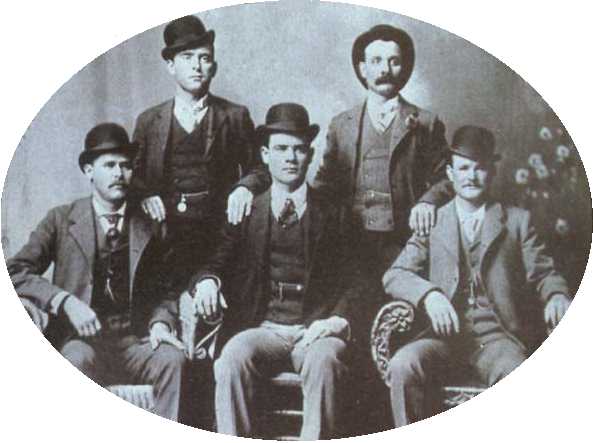
The Wild Bunch, 1900, Photo by John Swartz, 705 1/2 Main Street, Ft. Worth
Left to Right: Standing, Bill Carver and Harvey Logan ("Kid Curry")
Seated, Harry Longbough ("the Sundance Kid"), Ben Kilpatrick ("the Tall Texan"), Robert Leroy Parker ("Butch Cassidy")
On August 13, 1896, shortly before closing time, three men, hitched their horses to
a hitching rail across the street from the
Bank of Montpelier, Idaho. The bank, a one-story false fronted structure, had been founded 5 years earlier by
G. C. Gray who served as cashier. Later the bank would move to a larger two-story brick building before it
failed in 1924. Two of the men wearing bandanas came across the street and forced Gray who was on
the sidewalk in front of the bank into the bank building. Inside, the
teller, A. N. MacKintosh, was forced against a wall, and the two proceeded to
relieve the bank of an estimated $16,500. From his position against the wall,
MacKintosh was able to see through the window the third man, who he was later able to identify as
Bob Meeks, tending to the get-away horses. The two left the bank and and the three rode leisurely away.
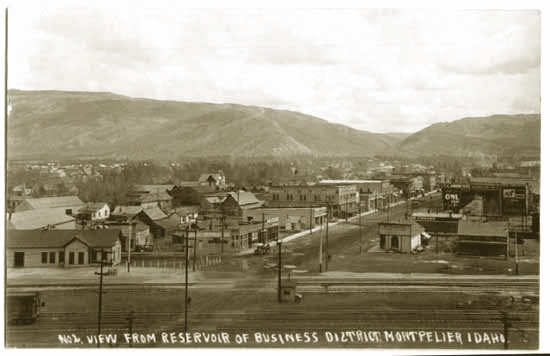
Montpelier, Idaho, approx. 1910
Chase was given by Deputy Sheriff Fred Cruikshank on a bicycle and by lawyer
John A. Bagley on horse back. Sheriff Jefferson M. Davis soon organized a posse which
also gave chase, but the three made good their escape. Later, based on the identification
by MacKintosh,
Meeks was arrested and convicted of the robbery. The other two, now believed to have been
Butch Cassidy and Elzy Lay, were never arrested for the robbery.
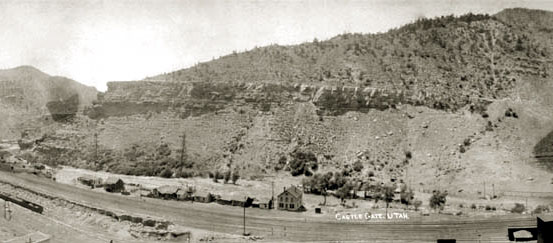
Castle Gate, Utah, 1913
In April, 1897, a lone cowboy arrived in Castle Gate, Utah, a large coal camp owned by the
Pleasant Valley Coal Company. The cowboy hitched his horse and proceeded to the saloon.
When the whistle of the noon train was heard, the cowboy rode down to the depot and watched the puffing train pull into
the station. The cowboy sat and watched. Each day for a week, the cowboy followed the same routine until the
locals paid no attention apparently thinking it to be merely a cowboy
eccentricity. On Wednesday, April 21, the same routine was followed. On that afternoon,
however, the baggage and express was unloaded into the baggage room, followed by the mining company
paymaster, E. L. Carpenter and two guards. From the baggage room, the three emerged bearing three bags of
coin and bank notes, a total of $8,800.00. The three headed to the Company office, on the
second floor of the company store, some 75 yards from the depot. Access to the
office was by way of an outside stairway.

Castle Gate, Utah
In the above photo, the Company office is the two-story stone building immediately on the other side of the
tipple. Near the stairway, two cowboys loitered. Passersby paid no heed to
the lone cowboy or to the other two. The lone cowboy, vi et armis, relieved Carpenter of a bag holding
$8,000, while one of the loiterers took from one of the guards a bag of coin. A customer in the
store, Frank Caffey, attempted to interfere with the proceedings but was greeted by a six shooter aimed at his
ample belly. The three cowboys, now believed to be Butch Cassidy, Elzy Lay, and possibly
a cowboy named Fowler, accompanied by several others, rode off to the south pursued by
Caffey in a buggy; an unarmed citizen on horseback shouting, "Bring that
money back"; and by a switch engine loaded with an impromtu posse. Neither Caffey, the citizen, or the switch
engine were able to catch up
with the robbers. Attempts to reach the Sheriff by telephone were unsuccessful. The telephone line
had been cut.
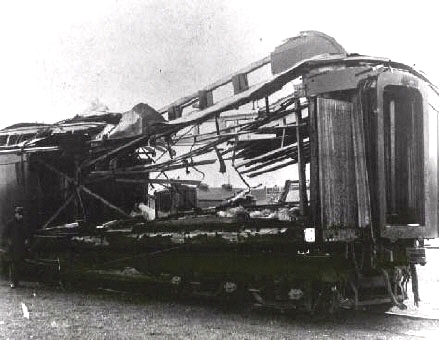 Remains of express car after Wilcox robbery.
Remains of express car after Wilcox robbery.
At 1:00 a.m. June 2, 1899, a trestle across the Union Pacific near Wilcox, Wyoming, about six miles west of
Old Rock Creek Station, was barricaded, forcing the
Overland Flyer to a halt. Men, wearing masks made from white napkins possibly stolen from
a Harvey House Restaurant, boarded the train. One of the men, after attempting to force the
engineer to pull the train forward, himself pulled the train forward. The trestle was then
dyamited so as to prevent the second section of the train from catching up. Additionally, two cars were separated from the
train. The train was then pulled forward for about two miles and stopped. There the express car was surrounded.
and the attendant by the name of E. C. Woodcock was
ordered by the gang to open the door. When he refused, the car was blown up. Woodcock, from the
concussion received in the explosion, was unable to remember the combination to the safe.
Whereupon, the safe was blown up and robbed of $30,000. Some of the bank notes were scorched by
the explosion or stained with raspberries also in the car.
Notwithstanding that the men were masked, immediate suspicion fell on the Wild Bunch led by Butch Cassidy. As reported
by the Sun-Leader on June 3:
There are some who claim that the robbery was the work of the Hole-in-the-Wall gang, and that "Butch"
Cassidy and this gang are the guilty ones. Some of the gang are said to have been returning from the
south where they wintered, and this was the spring opening."
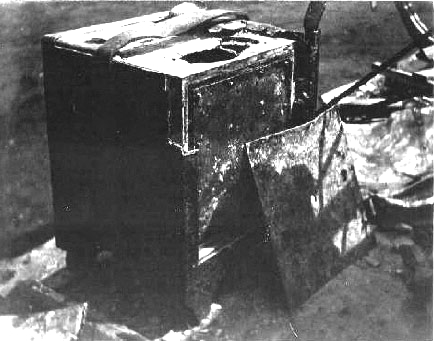 Remains of the express car safe.
Remains of the express car safe.
Other newspapers identified the culprits as the Roberts brothers. Thus, on June 8 the Wyoming Derrick reported the
robbers to be George Curry and the Roberts brothers. This information was repeated several days
later by the Sun-Leader. It is now believed that the name "Roberts" was a nom de guerre used by
Sundance and Harvey Logan.
At least some of the robbers were believed to be heading for Hole-in-the-Wall Country. Posses gave chase. Near Teapot Creek some of the culprits were cornered by a posse led by Converse
County Sheriff Joe Hazen. In the ensuing fire fight, Sheriff Hazen was killed
and the
train robbers made their escape by swimming across the river.
Several of the robbers were also suspected as those that robbed Daniel B. Budd's general store and the post office
in Big Piney. A description was given of the Big Piney robbers:
One is about five feet nine or ten inches in height; about
26 years old, light complexion, inclined to be florid; light hair and eyes; Weight about 160
pounds; had a nickel-plated revolver with bone or pear handle.
Another of the men is about five foot six inches tall; dark complexion; dark or black mustache; dark eyes.
Robber No. 2 is about five feet eight inches tall.
In addition to $200.00 cash, they took from the
store skogy boots, cowboy spurs and overalls, blue flannel shirts, camel's hair underwear, brown
gauntlet goves, pocket knivies, a Meanea bridle, with chain and bit.
On August 29, 1900, train robbers, using the same modus operandi
robbed the Union Pacific No. 3 train near Tipton, Wyoming of $50,000 in gold. As fate would have it,
Woodcock was again the express car attendant. This time he opened the door. At the time, it was believed that five robbers participated in the holdup.
The robbers were pursued by a possee led by Sheriff McDaniel of Carbon County, Sheriff Peter Swanson of Sweetwater County and United States Marshal Frank Hadsell until the tracks of
the robbers were obliterated by a rain.
Five years later Ed Rankin, employed on a construction crew for the Farris-Haggarty tramway, discovered near
the headwaters of Cow Creek three bags bags in which the money from
the Tipton Robbery had originally been held.
The Wilcox and Tipton robberies, although sucessful, marked if not the beginning of the end of the
Wild Bunch at least the onset of the beginning of the end. In 1897, E. H. Harriman obtained control of the
railroad and began a major reconstruction of the road. Mr. Harriman took a personal
interest in all aspects of the operation of the railroad including apprehension of those
robbing his trains. Mr. Harriman was not a man to be triffled with. Among his efforts was the appointment of
special agents including Timothy Keliher, Joe LeFors, and Thomas Jefferson Carr. At the same time, modern communications
in the form of the telephone were extending out
from Cheyenne. By the 1890's long distance service had begun connecting major towns of Wyoming.
The company was notified of the Tipton robbery by
the railway conductor calling from a pay telephone. In the final analysis, instant communications by telephone proved the
undoing of the Wild Bunch. When Harvey Logan escaped from jail in Tennessee, his movements were traced by
phone.
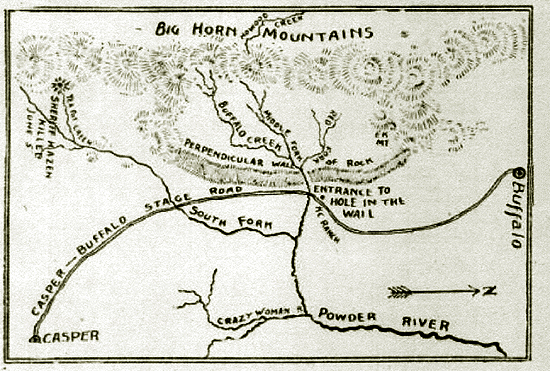
Map of the Hole-in-the-Wall Country showing relative positions of where
Sheriff Hazen was killed
and the entrance to the Hole-in-the-Wall.
On September 19, 1900, the
First National Bank at the corner of Bridge and Fourth Streets in Winnemucca, Nevada, was robbed. The bank robbers were identified as men who
had been camping in the area for at least 10 days.
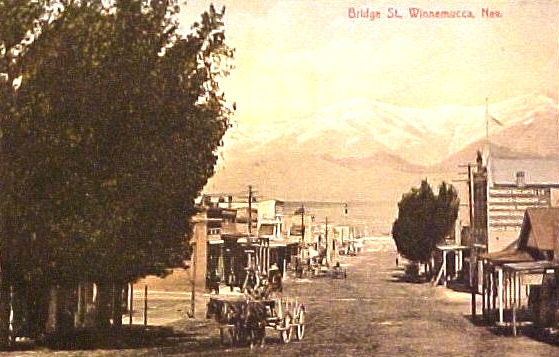
Winnemucca, Nevada, approx. 1905. Bank is the one-story brick building on the corner,
on the left, past the
trees and wagon.
It is the popular belief that Butch Cassidy committed both robberies. The difficulty, however, is that there
simply was not enough time for Cassidy to get from Tipton to Winnemucca by horseback in the time
available between the two robberies. The popular myth is that the photo at the
top of the page was mailed to George S. Nixon, the president of the bank, with a "thank you" note by Cassidy. This, however, is
not true. The photographer, John Swartz, thought the subjects of the photo were so distinquished that a copy of the
photo should be displayed as advertizing for his studio. As luck would have it, a Wells Fargo office was only a block
away at 817 Main. A Wells Fargo agent recognized the subjects in the photo and sent a copy to
Pinkertons, who, in turn, sent a copy to Nixon. Nixon averred that Cassidy was not one of the robbers. This, however,
does not eliminate the connection between the Winnemucca robbery and Wyoming. Several sources now contend that
the robbery was in fact commited by the Whitney brothers, Hugh and Charley, and their partner
Charley Manning, who frequented Wyoming's Star Valley. It is, however, doubtful that the Whitney Brothers pulled off
the heist. At the time, Hugh would have only been 12 years old and Charley 10. For discussion of the
Whitney Brothers see Cokeville.
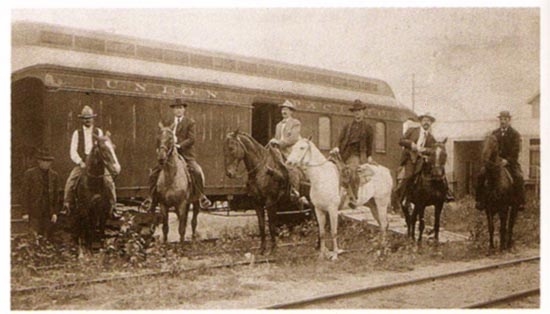
Posse organized to
give chase to Wild Bunch
L to R: Standing, Unidentified; On horse, George Hiatt, Timothy Keliher, Joe Lefors, H. Davis, S. Funk, Thomas Jefferson Carr.
The of use special agents with horses pre-positioned on railway cars to give chase to train robbers was the idea of
E. H. Harriman, President of the Union Pacific. Division Superintendent, W. H. Park, explained:
The Wyoming division of the Union Pacific
had long been a Mecca for outlaws.
The mountainous region on each side of the road, within
an average distance of a hundred miles, afforded opportunities
for the "get-away" which is essential in the
highwayman's profession. The trains were held up
early in the evening, and before a posse could be organized
the bandits were in the Hole-in-the-Wall-country
to the north, or in Brown's Park, or the North Park
country south, where the trail was invariably lost. Mr.
Harriman, with his knowledge of the horse, suggested
that we find horses that could go one hundred miles
in a day and keep them in the service of our special
agents, to be moved about from place to place on
trains and in the country. This was done and cured
the trouble. Thereafter the Union Pacific suffered no
holdups, although the Northern Pacific, Great Northern,
and Denver & Rio Grande were frequently victims.
Our posse of train guards, which became quite
celebrated, was composed of the best hunters and
guides. One of them — Joe La Force [sic] — was made
famous in Spearman's novel, " Whispering Smith."
Sam Lawson, formerly guide and hunter for Lord and
Lady Brassey, was always to be depended upon. Mr.
Timothy Keliher had immediate charge of the guards
and their equipment, and so maneuvered them that
complete exemption was obtained from attacks. As quoted by Kennan, George: E. H. Harriman: A Biography
Houghton Mifflin Company, Boston, 1922.
Keliher, chief special agent for the railroad and Joe LeFors, were allegedly used by Frank H. Spearman as a
composite model for his character "Whispering Smith" in a
series of novels. Spearman had met Keliher and Joe LeFors in bar of the Inter-Ocean Hotel while doing
research for his 1906 novel Whispering Smith. There had in
fact been a railroad detective, James L. "Hawkbill" Smith (1838-1914), more commonly called "Whispering Smith." Unlike,
Spearman's character, the real Smith, a former member of the
New Orleans Police and originally from Maryland, did not always play by the
rules. Smith moved to Omaha where he was employed by the
U.P.He was terminated after being inolved in two shootings and two lynchings.
He was also accused of corruptly stealing from persons he arrested while
serving on the Cheyenne Police Department. He was the deputy on the stage taking the
infamous rustler, Cornelius "Lame Johnny" Donahue, from Chadron to Rapid City for trial.
The stage messenger and guard had left the stage. Shortly thereafter the
stage was stopped by two unidentified masked men who hanged Donahue. Smith then moved to New Mexico where he
was again involved in several shootings and challenged Pat Garrett to a duel.
He later moved to Utah and was involved in the search for the
Wild Bunch after the Pleasant Valley Coal Company robbery. In Price, Utah,
he participated in a shootout in the Denver & Rio Grande railway depot.
His last shooting was as a prison guard at age 72 in Colorado. In 1914, Smith committed suicide while an
inmate in the Denver Jail. For more on Whispering Smith,
see Deadwood Stage
Next Page: Butch Cassidy and Sundance Kid in Argentina.
|